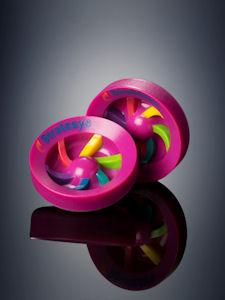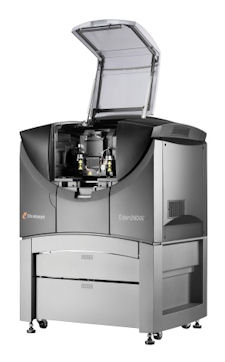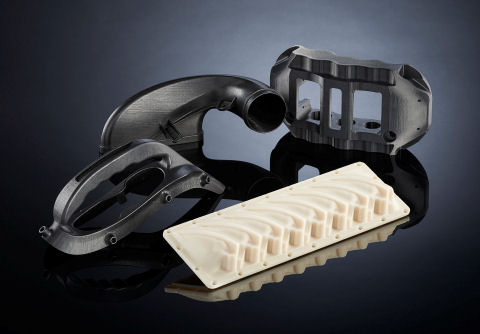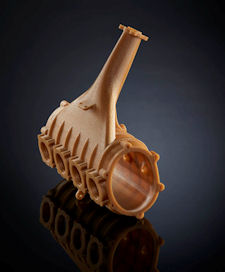Latest News
November 19, 2014
 The Objet Connex3 series provides designers and manufacturers multi-color, multi-material 3D printing in a single pass. Image courtesy of Stratasys Ltd.
The Objet Connex3 series provides designers and manufacturers multi-color, multi-material 3D printing in a single pass. Image courtesy of Stratasys Ltd.Stratasys Ltd. has announced 10 new 3D printers and a new high-performance thermoplastic modeling material for its Fortus 900mc 3D production system. The scope and breadth of new capabilities introduced, says Stratasys, will enable its “customers to improve their competitiveness and deliver high-end prototypes and manufactured parts with greater ease, speed and efficiency.” The new 3D printers include eight new Objet 3D printers and two new Fortus 3D production systems. Technology highlights of the announcement cover such features as triple-jetting technology, up to 20% faster FDM (fused deposition modeling) production system times, the ability to create 3D tools for food processing, and the ability to make 3D parts that can be steam-sterilized for medical applications.
Earlier this year, Stratasys unveiled the Objet500 Connex3. That printer’s triple-jetting technology made it the first 3D printer able to combine multiple colors with multiple printing materials in a single run, according to Stratasys. Each of the new PolyJet technology-based Objet 3D printers just announced offer triple-jetting technology.
 The Objet Eden260VS is the first PolyJet technology-based 3D printer to provide a soluble support removal process. Image courtesy of Stratasys Ltd.
The Objet Eden260VS is the first PolyJet technology-based 3D printer to provide a soluble support removal process. Image courtesy of Stratasys Ltd.Six of the eight new Objet printers are in the Objet260 Connex1, 2 and 3 series and the Objet350 Connex1, 2 and 3 series. The Objet260 Connex models are compact and office-friendly systems with a 10.0 x 9.9 x 7.9 in. build area. Objet260 Connex1 offers 14 base materials, including rubber-like, transparent and simulated polypropylene. The Objet260 Connex2 handles 120 materials and has the ability to combine as many as 27 material properties in a single part. The Objet260 Connex3 provides color 3D printing and can combine dozens of colors in a single prototype.
The Objet350 Connex series delivers the same capabilities as the Objet260 Connex series only with a larger build size. Build sizes for the Objet350 Connex series are 13.4 x 13.4 x 7.9 in. All six 3D printers offer hot-swappable material changeovers. Additionally, the Objet260 and Objet350 Connex3 3D Printers, as well as the existing Objet500 Connex3, will soon offer support for VRML-exported CAD files in addition to the traditional STL.
Rounding out the new Objet line of 3D printers are the Objet30 Prime and the Objet Eden260VS. Both printers, Stratasys says, are suitable for desktop and professional applications.
Stratasys reports that the Objet30 Prime is its most advanced PolyJet 3D printer. Described as suitable for prototyping and workgroup environments, the printer can handle 12 material options, including rubber-like and biocompatible materials. Users can prototype soft-touch parts as well as end-use soft materials such as gaskets, plugs and seals. The Objet30 Prime has an 11.57 x 7.55 x 5.85 in. build size. For user timesaving and material-efficiency, the Objet30 Prime offers a draft mode print option that enables 3D printing of models and parts at 36-micron layers.
The ObjetEden260VS introduces the first soluble support removal process for PolyJet technology. With this feature, users can create delicate, finely detailed models with small cavities, says Stratasys. This capability is compatible with the company’s VeroGray, VeroBlue, VeroClear and VeroWhitePlus PolyJet materials.
Stratasys adds that the ObjetEden260VS 3D printer is ideal for users in the consumer goods design, research and service bureau industries. It offers high-quality precision prototyping with 16-micron layers and a build envelope of 10 x 9.9 x 7.9 in.
The newly announced Fortus 450mc and Fortus 380mc Production Systems feature a new touch-screen interface that allows users to make adjustments to print jobs without disrupting operations. Additionally, the new printers can achieve up to 20% quicker build times for complex geometries than was possible with its predecessors. Available materials for the Fortus 450mc and Fortus 380mc include ABS (acrylonitrile butadiene styrene), ASA (acrylonitrile styrene acrylate), PC (polycarbonate), nylon and ULTEM 9085.
The Fortus 450mc can produce layer resolutions from 0.005 in. to 0.013 in., and manufacture parts up to 15% faster than the previous generation of Fortus systems. It has a capacity for two modeling materials and two support material canisters. Its build envelope is 16 x 14 x 16 in.
The Fortus 380mc is reported to provide even temperature distribution in its build chamber. It has a 14 x 12 x 12 in. build envelope and offers the same layer resolutions as the Fortus 450mc.
Stratasys calls the new ULTEM 1010 material a high-performance thermoplastic for FDM that offers heat resistance, tensile strength and chemical resistance. Compatible with the Fortus 900mc 3D Production System, ULTEM 1010 can be used to 3D print medical tools like surgical guides that can withstand steam autoclaving. The material can be used to build temperature-resistant dies, patterns and fixtures for food production as well as manufacture out-of-cabin aerospace components and under-the-hood automotive components such as housings, ducts and semi-structural components, according to the company. Stratasys adds that ULTEM 1010 is the sole FDM material with an NSF 51 food-contact certification. Additionally, it’s biocompatible with an ISO 10993/USP Class VI certification.
“This new generation of [Fortus] 3D printers is aimed to improve the customers’ overall experience,” said Bill Schultz, senior director of FDM products for Stratasys in a press statement. “Improved system navigation, system maintenance, and system performance builds upon the proven history of the Fortus family of products. Complex geometries now take less time to print with our new systems.”
For more information including brochures and spec sheets about the new Objet260 and Objet 350 Connex series, the Objet30 Prime, the Objet Eden260VS, the Fortus 450mc, the Fortus 380mc, and ULTEM 1010 material, click on the links below.
Click here for more on the Objet260 Connex1, 2 and 3 series 3D printers.
Click here for more on the Objet350 Connex1, 2 and 3 series 3D printers.
Click here for more on the Objet30 Prime 3D printer.
Click here for more on the Objet Eden260VS 3D printer.
Click here for more on the Fortus 450mc and Fortus 380mc 3D printers.
Click here for more on the ULTEM1010 high-performance thermoplastic for FDM.
Click here to read about Stratasys’ new offerings on DE’s Rapid Ready blog.
Sources: Press materials received from the company and additional information gleaned from the company's website.
Subscribe to our FREE magazine, FREE email newsletters or both!
Latest News
About the Author
Anthony J. Lockwood is Digital Engineering’s founding editor. He is now retired. Contact him via [email protected].
Follow DE







